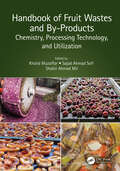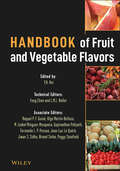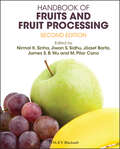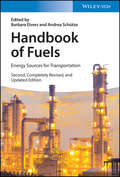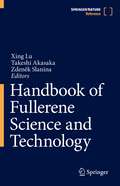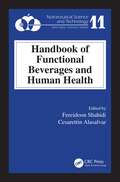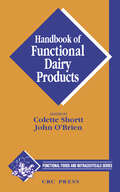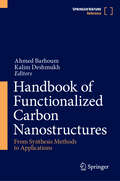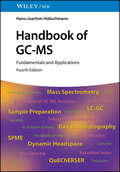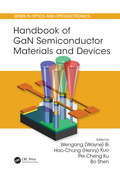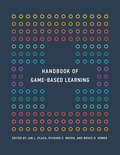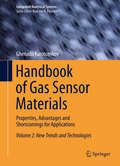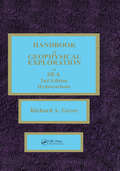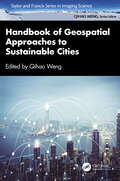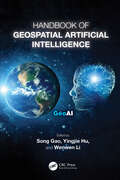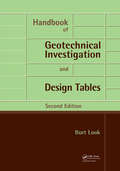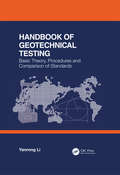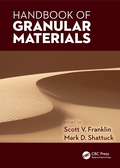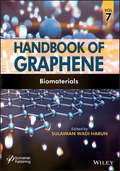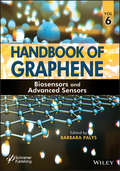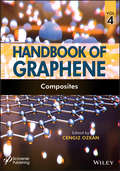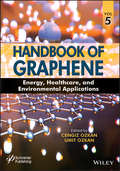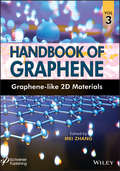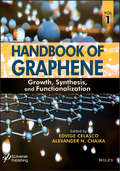- Table View
- List View
Handbook of Fruit Wastes and By-Products: Chemistry, Processing Technology, and Utilization
by Khalid Muzaffar, Sajad Ahmad Sofi, and Shabir Ahmad MirProcessing of fruits produces large volumes of wastes and these wastes can create pollution problems and also result in loss of valuable biomass and nutrients. The Handbook of Fruit Wastes and By-Products: Chemistry, Processing Technology, and Utilization deals with the various techniques and methods involved in processing of fruit by-products. Although there are some general books on by-products of food processing industry but they are limited in context to the by-products of some particular fruits. This is the first book devoted to fruit processing by-products of wide range of important fruits including tropical, subtropical and temperate fruits; and their possible utilization in food and non-food industries. Key Features Discusses the valorization of fruit processing by-products Covers the role of the by-products as prebiotics and dietary fibers Presents extraction techniques of bioactive compounds from fruit wastes This book provides in-depth information about the fruit processing by-products, their nutritional composition, biochemistry, processing technology of by-products and the utilization of by-products into various food applications. This book also offers comprehensive coverage on the role of the fruit by-products as prebiotics and dietary fibers, their potential as the source of bioactive ingredients and their utilization in the development of novel functional foods. It also includes various novel technologies useful in extraction and evaluation of the functional components from these fruit processing by-products. The book addresses how the proper utilization of fruit processing by‐products would not only emerge as a source of extra profit to the fruit processing industry but also will help in lessen the environment pollution due to these fruit processing by-products.
Handbook of Fruit and Vegetable Flavors
by Peggy Stanfield Y. H. Hui Gopinadhan Paliyath Feng Chen L. M. Nollet Raquel P. F. Guin? Olga Mart?n-Belloso M. Isabel M?nguez-Mosquera Fernando L. P. Pessoa Jean-Luc Le Qu?r? Jiwan S. Sidhu Nirmal SinhaActing as chemical messengers for olfactory cells, food flavor materials are organic compounds that give off a strong, typically pleasant smells. Handbook of Fruit and Vegetable Flavors explores the flavor science and technology of fruits and vegetables, spices, and oils by first introducing specific flavors and their commercialization, then detailing the technical aspects, including biology, biotechnology, chemistry, physiochemistry, processing, analysis, extraction, commodities, and requirements for application as food additives. With chapter authors representing more than ten different countries, this handy reference provides a comprehensive view of this evolving science.
Handbook of Fruits and Fruit Processing: Production, Postharvest Science, Processing Technology And Nutrition
by Nirmal K. Sinha Jiwan S. Sidhu M. Pilar Cano József Barta James S. B. WuFruits are botanically diverse, perishable, seasonal and predominantly regional in production. They come in many varieties, shapes and size, colors, flavors and textures and are an important part of a healthy diet and the global economy. Besides vitamins, minerals, fibers and other nutrients, fruits contain phenolic compounds that have pharmacological potential. Consumed as a part of a regular diet, these naturally occurring plant constituents are believed to provide a wide range of physiological benefits through their antioxidant, anti-allergic, anti-carcinogenic, and anti-inflammatory properties. Handbook of Fruits and Fruit Processing distils the latest developments and research efforts in this field that are aimed at improving production methods, post-harvest storage and processing, safety, quality and developing new processes and products. This revised and updated second edition expands and improves upon the coverage of the original book. Some highlights include chapters on the physiology and classification of fruits, horticultural biochemistry, microbiology and food safety (including HACCP, safety and the regulation of fruits in the global market), sensory and flavor characteristics, nutrition, naturally present bioactive phenolics, postharvest physiology, storage, transportation and packaging, processing and preservation technologies. Information on the major fruits includes tropical and super fruits, frozen fruits, canned fruit, jelly, jam and preserves, fruit juices, dried fruits and wines. The 35 chapters are organized into five parts: Part I: Fruit physiology, biochemistry, microbiology, nutrition and health Part II: Postharvest handling and preservation of fruits Part III: Product manufacturing and packaging Part IV: Processing plant, waste management, safety and regulations Part V: Production, quality and processing aspects of major fruits and fruit products Each chapter has been contributed by professionals from around the globe representing academia, government institutions and industry. The book is designed to be a valuable source and reference book for scientists, product developers, students and all professionals with an interest in this field.
Handbook of Fuels: Energy Sources for Transportation
by Barbara ElversA guide to industrially relevant products and processes for transportation fuels The Handbook of Fuels offers a comprehensive review of the wide variety of fuels used to power vehicles, aircraft and ships and examines the processes to produce these fuels. The updated second edition reflects the growing importance of fuels and fuel additives from renewable sources. New chapters include information on current production technology and use of bioethanol, biomethanol and biomass-to-liquid fuels. The book also reviews novel additives and performanace enhancers for conventional engines and fuels for novel bybrid engines. This comprehensive resource contains critical information on the legal, safety, and environmental issues associated with the production and use of fuels as well as reviewing important secondary aspects of the use and production of fuels. This authoritative guide includes contributions from authors who are long-standing contributors to the Ullmann's Encyclopedia, the world's most trusted reference for industrial chemistry. This important guide: Contains an updated edition of the authoritative resource to the production and use of fuels used for transportation Includes information that has been selected to reflect only commercially relevant products and processes Presents contributions from a team of noted experts in the field Offers the most recent developments in fuels and additives from renewable sources Written for professionals in the fields of fossil and renewable fuels, engine design, and transportation, Handbook of Fuels is the comprehensive resource that has been revised to reflect the recent developments in fuels used for transportation.
Handbook of Fullerene Science and Technology
by Takeshi Akasaka Xing Lu Zdeněk SlaninaNanocarbon chemistry and physics is a fast-developing, broad research area – the Nobel prizes in 1996 and 2010 awarded to two key discoveries in the field, and several other nanocarbon achievements of comparable importance. Owing to this rapid growth, the nanocarbon landscape fundamentally changes every few years, creating a need to survey the field on a regular basis to update the books that have become incomplete or even obsolete. As such, this book focuses on fullerenes and metallofullerenes and also on the related areas of nanotubes and graphenes. All the covered research topics provide important fundamental knowledge for the natural sciences, but also for applications in molecular electronics, superconductivity, catalysis, photovoltaics and medical diagnostics. The current nanocarbon research activities have particularly high application potential in the conversion of solar energy, future molecular memories, non-conventional materials for optoelectronics, and new treatments for civilization diseases. Offering a truly up-to-date critical survey of nanocarbon science, its concepts and highlights, it follows the concept of a handbook: it addresses key topics systematically, from historical background, methodological aspects, current important issues, and application potential, all supplied with extensive referencing. With individual chapters written by leading experts with extensive research experience, it is a comprehensive reference resource for graduate students and active researchers alike.
Handbook of Functional Beverages and Human Health (Nutraceutical Science and Technology)
by Fereidoon Shahidi Cesarettin AlasalvarHandbook of Functional Beverages and Human Health provides potential applications and new developments in functional beverages, nutraceuticals, and health foods. In addition to serving as a reference manual, it summarizes the current state of knowledge in key research areas and contains novel ideas for future research and development. Additionally,
Handbook of Functional Dairy Products (Functional Foods and Nutraceuticals)
by John O’Brien Colette ShorttHandbook of Functional Dairy Products reveals key advances in the field, explores the product development process, and identifies the market dynamics driving product innovation. Chapters examine specific ingredients and products, safety and technology issues, the impact of biotechnology, the regulatory environment, and the communication of health benefits. With an emphasis on the potential contribution of functional dairy products in the maintenance of health and prevention of disease, the book includes in-depth discussions of probiotics, dairy-derived carbohydrates and prebiotics, bioactive peptides, the immune modulating effects of dairy ingredients, the health effects of conjugated linoleic acid (CLA), and calcium and iron fortifi
Handbook of Functionalized Carbon Nanostructures: From Synthesis Methods to Applications
by Ahmed Barhoum Kalim DeshmukhThis book highlights all newly reported carbon nanostructures including graphene and its derivatives, carbon nanotubes, metal organic frameworks, fullerenes, nanorods, nanospheres, nano onions, porous nanoparticles, nanohorns, nanofibers and nanoribbons, nanodiamonds, graphitic carbon nitrides, carbon aerogels and hydrogels, graphdiyne and graphenylene. It presents the historical development of carbon nanostructures technologies, different types and classifications, and different fabrication and functionalization techniques, including outer/inner surface functionalization and covalent and noncovalent functionalization. This Handbook discusses the unique properties of functionalized carbon nanostructures that can be obtained by modifying their structures, composition, and surface. It gives the reader an in-depth look at the current achievements of research and practice while pointing you ahead to new possibilities in functionalizing and using carbon nanomaterials. Finally, it covers the various applications of functionalized carbon nanostructures including adsorbents, additives, active materials in energy accumulating systems (batteries, hydrogen storage systems, and supercapacitors), filtering media, catalysts or supports for catalysts, sensors or substrates for sensors, additives for polymers, ceramic composites, metal and carbon alloys, glasses, digital textiles, and composite materials.
Handbook of Functionalized Nanostructured MXenes: Synthetic Strategies and Applications from Energy to Environment Sustainability (Smart Nanomaterials Technology)
by Anish Khan Komal Rizwan Abdullah Mohammed Ahmed AsiriThis book covers the various aspects of MXenes nanomaterials and its composites from the fabrication to the potential applications in energy devices, sensors, and environmental remediation. MXenes are two-dimensional (2D) transition metal carbides and nitrides which contains novel combination of properties including great conductivity and mechanical, thermal features of transition metal carbide and nitrides. In addition, MXenes nanomaterials possess high surface area, novel morphology, and layered structure and the functionalized of its surfaces gives it excellent hydrophilic characteristics and high absorption of electromagnetic radiations making them versatile materials for various applications. The beginning part of the book gives an in-depth literature covering the fundamental principles, fabrication, self-assembling strategies of nano-engineered MXenes, and their composites materials. The later chapters describe the chemical functionalization of MXenes nanomaterials for diversified applications such as electromagnetic shielding, energy storage devices (super capacitors, lithium ion batteries, CO2 capture, optical switching, transistors), photo catalysis, drug delivery, implants, tissue engineering, water purification, and sensing applications. It demonstrates that MXene-based advanced architectures promote continuous innovations and provide driving force in different fields particularly in environmental remediation and energy storage devices. This book is essential reading for all chemists, biologists, physicists, and environmental scientists working in the field of nanotechnology, energy, and environmental chemistry. It helps academics and professionals to polish their knowledge with the latest described data. It also helps professionals in developing innovative technologies by keeping in mind the applications of functionalized nanostructured MXenes.
Handbook of GC-MS: Fundamentals and Applications
by Hans-Joachim HubschmannEssential handbook for all analytical scientists and laboratories using GC-MS, covering both the fundamental and practical aspects of this analytical technique From essentials to applications, Handbook of GC-MS:Fundamentals and Applications is a comprehensive reference and training compendium on the popular and evolving technique of GC-MS (gas chromatography/mass spectrometry), guiding readers through the most used sample preparation methods for GC-MS and method development, with many practical indications supporting the design of optimized analyses, and providing practical approaches to data processing, compound identification, and quantification. The text details both a solid background and principles of operation, as well as a broad range of current real-life examples taken from laboratories in environmental, food, pharmaceutical, and forensic analysis. It also features a glossary of more than 300 terms, and a comprehensive substance index that facilitates finding a specific application. This timely Fourth Edition covers the latest developments in automated sample preparation techniques and instrumentation, also with the focus on Green Analytical Chemistry. This comprehensive handbook presents GC-MS applications in various fields, with coverage of the well-known QuEChERS pesticide extraction, solid phase extraction and solid phase microextraction, static and dynamic headspace analysis, liquid/liquid extraction, outgassing, and thermal desorption, including pyrolysis. Single and triple quadrupole, Orbitrap, time-of-flight, magnetic sector, ion mobility and isotope ratio MS are discussed with their advantages and limitations. Sample topics covered in Handbook of GC-MS: Fundamentals and Applications include: Sample inlet systems for hot needle, liquid band injection with large volume and LC-GC application, carrier gas saving, choice of columns, septa and injection port linersOptimization of the GC method with carrier gas flow, effect of oven temperature ramp rates, fast GC, and multi-dimensional gas chromatographyIonization processes, electron and chemical ionization, resolution power in mass spectrometry, reading and interpreting mass spectraExtraction of mass spectra, manual spectrum subtraction, deconvolution of mass spectra, retention index, and library search of mass spectraTypical mass spectra of common analyte groups like pesticides, persistent organic pollutants, drugs; explosives; and of frequently occurring impuritiesQuantification using external and internal standards and standard addition methods. Determination of the limits of detection and quantitation.Applications covering food, water, flavor and fragrance, metabolomics, forensic and material analysis The Handbook of GC-MS: Fundamentals and Applications is an essential reference for the daily GC-MS practice and application of new methods. It serves as an excellent introduction for newcomers as well as an educational resource about this analytical technique. Analytical chemists, chromatographers, environmental chemists, food chemists, and pharmaceutical chemists will find it of high practical use.
Handbook of GaN Semiconductor Materials and Devices (Series in Optics and Optoelectronics)
by Bo Shen Wengang Wayne Bi Haochung Henry Kuo Peicheng KuThis book addresses material growth, device fabrication, device application, and commercialization of energy-efficient white light-emitting diodes (LEDs), laser diodes, and power electronics devices. It begins with an overview on basics of semiconductor materials, physics, growth and characterization techniques, followed by detailed discussion of advantages, drawbacks, design issues, processing, applications, and key challenges for state of the art GaN-based devices. It includes state of the art material synthesis techniques with an overview on growth technologies for emerging bulk or free standing GaN and AlN substrates and their applications in electronics, detection, sensing, optoelectronics and photonics. Wengang (Wayne) Bi is Distinguished Chair Professor and Associate Dean in the College of Information and Electrical Engineering at Hebei University of Technology in Tianjin, China. Hao-chung (Henry) Kuo is Distinguished Professor and Associate Director of the Photonics Center at National Chiao-Tung University, Hsin-Tsu, Taiwan, China. Pei-Cheng Ku is an associate professor in the Department of Electrical Engineering & Computer Science at the University of Michigan, Ann Arbor, USA. Bo Shen is the Cheung Kong Professor at Peking University in China.
Handbook of Game-Based Learning (The\mit Press Ser.)
by Jan L. Plass Richard E. Mayer Bruce D. HomerA comprehensive introduction to the latest research and theory on learning and instruction with computer games.This book offers a comprehensive introduction to the latest research on learning and instruction with computer games. Unlike other books on the topic, which emphasize game development or best practices, Handbook of Game-Based Learning is based on empirical findings and grounded in psychological and learning sciences theory. The contributors, all leading researchers in the field, offer a range of perspectives, including cognitive, motivational, affective, and sociocultural. They explore research on whether (and how) computer games can help students learn educational content and academic skills; which game features (including feedback, incentives, adaptivity, narrative theme, and game mechanics) can improve the instructional effectiveness of these games; and applications, including games for learning in STEM disciplines, for training cognitive skills, for workforce learning, and for assessment. The Handbook offers an indispensable reference both for readers with practical interests in designing or selecting effective game-based learning environments and for scholars who conduct or evaluate research in the field. It can also be used in courses related to play, cognition, motivation, affect, instruction, and technology.ContributorsRoger Azevedo, Ryan S. Baker, Daphne Bavelier, Amanda E. Bradbury, Ruth C. Clark, Michele D. Dickey, Hamadi Henderson, Bruce D. Homer, Fengfeng Ke, Younsu Kim, Charles E. Kinzer, Eric Klopfer, James C. Lester, Kristina Loderer, Richard E. Mayer, Bradford W. Mott, Nicholas V. Mudrick, Brian Nelson, Frank Nguyen, V. Elizabeth Owen, Shashank Pawar, Reinhard Pekrun, Jan L. Plass, Charles Raffale, Jonathon Reinhardt, C. Scott Rigby, Jonathan P. Rowe, Richard M. Ryan, Ruth N. Schwartz, Quinnipiac Valerie J. Shute, Randall D. Spain, Constance Steinkuehler, Frankie Tam, Michelle Taub, Meredith Thompson, Steven L. Thorne, A. M. Tsaasan
Handbook of Gas Sensor Materials
by Ghenadii KorotcenkovThe two volumes of Handbook of Gas Sensor Materials provide a detailed and comprehensive account of materials for gas sensors, including the properties and relative advantages of various materials. Since these sensors can be applied for the automation of myriad industrial processes, as well as for everyday monitoring of such activities as public safety, engine performance, medical therapeutics, and in many other situations, this handbook is of great value. Gas sensor designers will find a treasure trove of material in these two books.
Handbook of Geophysical Exploration at Sea
by Richard A. Geyer Margaret AshwellThis two-volume handbook presents advanced research and operational information about hard minerals and hydrocarbons. It provides information in an integrated, interdisciplinary manner, stressing case histories. It includes review chapters, illustrations, graphs, tables, and color satellite images that present the results of gravity, geodetic, and seismic surveys and of 3-D sea floor sub-bottom visualizations. The data was obtained using satellites, aircraft, and ships from the Atlantic and Pacific Oceans, the Gulf of Mexico, and the Caribbean Sea. Major topics addressed in these volumes include geophysical methods used to explore for hydrocarbons, advanced radiometric and electrical methods for hard mineral searches, the role of geotechnology and seismic acoustics in overcoming geological hazards in selecting drilling sites and pipeline routes, and remote sensing techniques used to determine the physical properties of sediments.
Handbook of Geospatial Approaches to Sustainable Cities (Imaging Science)
by Qihao Weng Cheolhee YooThis comprehensive handbook presents the current state of knowledge on geospatial technologies, techniques, and methods that are imperative for providing solutions to sustainable cities. It addresses the role of geospatial big data and AI techniques and how they are applied when analyzing the sustainability of urban development, land use, urban planning, and resource management, as well as monitoring the impact urbanization has on the environment and the ecosystem. Taking an interdisciplinary approach to sustainable cities, and with contributions from renowned experts around the world, this holistic handbook is a toolbox for geospatial, urban, and sustainability professionals, the artificial intelligence community, and those who work in related fields. Features: Explores cutting-edge geospatial and AI techniques in support of efficient, resilient, digital, and smart cities Bridges urban science and sustainability science via geospatial methods Contributes to the efforts of GEO by addressing and exemplifying pertinent societal benefit areas and engagement priorities Includes 16 case studies with a broad geographic scope that integrate societal needs with technological advances Draws expertise in geospatial technology, big data, and artificial intelligence from leading experts in the world This book is intended for researchers and scientists interested in learning techniques in GeoAI, including the technologies for collecting, analyzing, managing, processing, and visualizing geospatial datasets.
Handbook of Geospatial Artificial Intelligence
by Song Gao Yingjie Hu Wenwen LiThis comprehensive handbook covers Geospatial Artificial Intelligence (GeoAI), which is the integration of geospatial studies and AI machine (deep) learning and knowledge graph technologies. It explains key fundamental concepts, methods, models, and technologies of GeoAI, and discusses the recent advances, research tools, and applications that range from environmental observation and social sensing to natural disaster responses. As the first single volume on this fast-emerging domain, Handbook of Geospatial Artificial Intelligence is an excellent resource for educators, students, researchers, and practitioners utilizing GeoAI in fields such as information science, environment and natural resources, geosciences, and geography. Features Provides systematic introductions and discussions of GeoAI theory, methods, technologies, applications, and future perspectives Covers a wide range of GeoAI applications and case studies in practice Offers supplementary materials such as data, programming code, tools, and case studies Discusses the recent developments of GeoAI methods and tools Includes contributions written by top experts in cutting-edge GeoAI topics This book is intended for upper-level undergraduate and graduate students from different disciplines and those taking GIS courses in geography or computer sciences as well as software engineers, geospatial industry engineers, GIS professionals in non-governmental organizations, and federal/state agencies who use GIS and want to learn more about GeoAI advances and applications.
Handbook of Geotechnical Investigation and Design Tables: Second Edition
by Burt G. LookThis practical handbook of properties for soils and rock contains in a concise tabular format the key issues relevant to geotechnical investigations, assessments and designs in common practice. There are brief notes on the application of the tables. These data tables are compiled for experienced geotechnical professionals who require a reference do
Handbook of Geotechnical Testing: Basic Theory Procedures And Comparison Of Standards
by Yanrong LiDetermination of the physical, chemical and mechanical properties of ground materials is the key to successfully deliver such projects as slope stabilization, excavation and lateral support, foundation etc. A book containing both theory of geomaterial testing and up-to-date testing methods is much in demand for obtaining reliable and accurate test results. This book is intended primarily to serve this need and aims at the clear explanation, in adequate depth, of the fundamental principles, requirements and procedures of soil and rock tests. It is intended that the book will serve as a useful source of reference for professionals in the field of geotechnical and geological engineering. It can work as a one-stop knowledge warehouse to build a basic cognition of material tests on which the readers are working. It helps college students bridge the gap between class education and engineering practice, and helps academic researchers guarantee reliable and accurate test results. It is also useful for training new technicians and providing a refresher for veterans. Engineers contemplating the ICE, IOM3 and other certification exams will find this book an essential test preparation aid. It is assumed that the reader has no prior knowledge of the subject but has a good understanding of basic mechanics.
Handbook of Granular Materials
by Scott V. Franklin Mark D. ShattuckGranular systems arise in a variety of geological and industrial settings, from landslides, avalanches, and erosion to agricultural grains and pharmaceutical powders. Understanding the underlying physics that governs their behavior is the key to developing effective handling and transport mechanisms as well as appropriate environmental policies.Han
Handbook of Graphene: Biomaterials
by Sulaiman Wadi HarunThe seventh volume in a series of handbooks on graphene research and applicationsThe Handbook of Graphene, Volume 7: Biomaterials presents an overview of various graphene research initiatives and specific biomedical applications, where the properties of graphene are used differently. The book shares information on how graphene and graphene-based materials are utilized for the following types of applications: bio-targeting; medical and biomedical; drug delivery; antibacterial; and biological, biosensing and bioimaging. Topics covered include the role of graphene-based materials in: regenerative medicine; resistive memories and transistors; and implants in biomedicine. The impact of graphene-based biomaterials on biomedical applications is discussed, as are graphene-based systems in the delivery of therapeutics to the brain and central nervous system.
Handbook of Graphene: Biosensors and Advanced Sensors
by Barbara PalysThe sixth volume in a series of handbooks on graphene research and applicationsThe Handbook of Graphene, Volume 6: Biosensors and Advanced Sensors discusses the unique benefits that the discovery of graphene has brought to the sensing and biosensing sectors. It examines graphene's use in leading-edge technology applications and the development of a variety of graphene-based sensors. The handbook looks at how graphene can be used as an electrode, substrate, or transducer in sensor design. Graphene-based sensor detection has achieved up to femto-levels, with performances delivering the advantages of greater selectivity, sensitivity, and stability.
Handbook of Graphene: Composites
by Cengiz OzkanThe fourth volume in a series of handbooks on graphene research and applicationsThe Handbook of Graphene, Volume 4: Composites looks at composite materials exclusively. Topics covered include graphene composites and graphene-reinforced advanced composite materials. The following graphene-based subjects are discussed: ceramic composites; composite nanostructures; composites with shape memory effect; and scroll structures. Chapters also address: the fabrication and properties of copper–graphene composites; graphene–metal oxide composite as an anode material in li-ion batteries; supramolecular graphene-based systems for drug delivery; and other graphene-related areas of interest to scientists and researchers.
Handbook of Graphene: Energy, Healthcare, and Environmental Applications
by Cengiz Ozkan Umit S. OzkanThe fifth volume in a series of handbooks on graphene research and applicationsGraphene is a valuable nanomaterial used in technology. The Handbook of Graphene: Graphene in Energy, Healthcare, and Environmental Applications is the fifth volume in the handbook series. The book's topics include: graphene nanomaterials in energy and environment applications and graphene used as nanolubricant. Within the handbook, three-dimensional graphene materials are discussed, as are synthesis and applications in electrocatalysts and electrochemical sensors. The battery topics cover: graphene and graphene-based hybrid composites for advanced rechargeable battery electrodes; graphene-based materials for advanced lithium-ion batteries; graphene-based materials for supercapacitors and conductive additives of lithium ion batteries. The book's graphene-based sensor information addresses flexible actuators, sensors, and supercapacitors.
Handbook of Graphene: Graphene-like 2D Materials
by Mei ZhangThe third volume in a series of handbooks on graphene research and applicationsGraphene is a valuable nanomaterial used in technology. This handbook is focused on Graphene-Like 2D Materials. The Handbook of Graphene, Volume 3 covers topics that include planar graphene superlattices; magnetic and optical properties of graphene materials with porous defects; and nanoelectronic application of graphyne and its structural derivatives.
Handbook of Graphene: Growth, Synthesis, and Functionalization
by Edvige Celasco Alexander N. ChaikaHandbook of Graphene, Volume 1, essentially focuses on graphene growth, synthesis, and functionalization in order to realize optimized graphene-based nanostructures which can be utilized for various applications. This handbook provides detailed and up-to-date overviews of the synthesis and functionalization of graphene on various substrates (metallic and semiconducting), their properties and possible application methods. In particular, the chapters cover: - Optimization of graphene growth and challenges for synthesis of high-quality graphene and graphite in metallic materials; - Exfoliation of graphene sheets obtained by sonication, ball milling and use of polymers and surfactants; - Structure, electronic properties, functionalization methods, and prospects of epitaxial graphene grown on hexagonal and cubic silicon carbide substrates; - Growth of graphene on Si(111) wafers via direct deposition of solid-state carbon atom and characterization of graphene-on-silicon films; - Chemical reactivity and modification of electronical properties of graphene grown on Ni(111); - Enhancement of the cell wall strength and stability of foam structure utilizing graphene; - Influence of applied strain and magnetic field on the electronic and transport properties of graphene with different kinds of defects; - Application of hydrogen functionalized graphene in spintronic nanodevices; - Electrochemistry and catalytic properties of graphene-based materials; - Functionalization of graphene with molecules and/or nanoparticles for advanced applications such as flexible electronics, biological systems, ink-jet applications and coatings; - Graphene-based composite materials devoted to electrochemical applications such as supercapacitors, lithium ion batteries and electrode material; - Three-dimensional graphene-based structures which preserve the intrinsic properties of 2D graphene and provide advanced functionalities with desired characteristics in a wide range of applications such as sensors, batteries, supercapacitors, fuel cells, etc.; - Carbon allotropes between diamond and graphite, which allow creating semiconductor properties in graphene and related structures. The 18 chapters of this handbook represent deep and very stimulating contributions to the processes of growth, synthesis and functionalization of graphene for several potential applications. This book is intended for students and active researchers in the field of graphene who are currently investigating the fundamental properties of this amazing low-dimensional material and its applications in micro- and nanotechnologies. It is also necessary reading for entrepreneurs and industrialists because it discusses a variety of possible applications of graphene and different ways of improving the quality of synthesized graphene.
